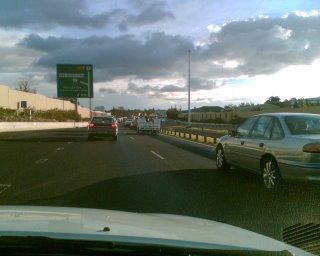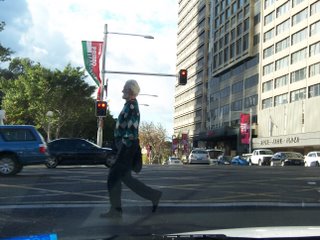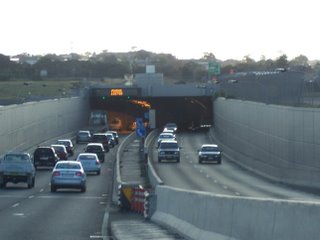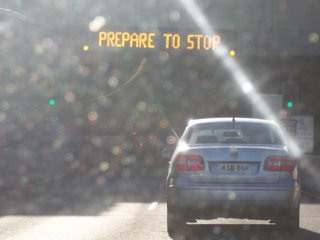In-tunnel filtration - a necessity?
In a common scenario for many Sydney residents, William Paniagua, a 27 year old electrical engineer from Strathfield, is running late for work and has no other option but to use the M5 tunnel. The traffic creeps through the entrance of the tunnel and then comes to a standstill.
One lane has been closed in order to comply with air quality standards, reducing the tunnel to half its capacity. This further delays the traffic and despite having his windows up and air conditioning on recirculate, as recommended by NSW Health, he can smell the pollution coming from the row of cars in front. With every breath of the tunnel air his chest tightens, making it a struggle to breathe.
"Just when I thought I wouldn’t make it through, I saw the light at the end of the tunnel!" Mr Paniagua said.
Mr Paniagua is one of a quarter of all Australians who suffers from asthma. He is concerned about the worsening air pollution in Sydney’s unfiltered tunnels, and is angry that the Government has failed to filter the M5 despite a recommendation from NSW Health that asthmatics and cyclists do not use the tunnel during peak traffic times.
"It’s ridiculous. Instead of telling people to put up their windows and not breathe in the air, or to stay away if they have asthma, the government should install filtering systems which make the air breathable." He said.
Mr Paniagua is not alone in his concerns. The Australian Bureau of Statistics has shown that air pollution is one of the greatest environmental concerns to Australians. The issue of filtering Sydney’s tunnels has been in the news frequently over the past few years. Concern first arose about the M5 tunnel and has extended to the Lane Cove Tunnel, which is due to open in 2007.
The main debate over in-tunnel filtration is centred on the New South Wales Government’s insistence that they are not an effective technology, both in terms of implementation and cost, while many residents see filtration as the solution to poor air quality in and around Sydney's tunnels.
Particles in pollution from vehicle exhausts is known to cause increases in death rates and hospital admissions around the world. Combine this with the fact that twice as many people died in Sydney in 2000 from air pollution than from road accidents.
A recent report into the health of resident around M5 East Road Tunnel Stack found a high incident of symptoms. Half of the people surveyed had eye problems, with 17 per cent saying they had severe symptoms. Two-thirds had nose problems, 32 per cent said they had frequent or severe nose symptoms. And a third of the participants had problems with their throat. Despite this the report recommended that no further action be taken, and phase three was cancelled.
The Lane Cove Tunnel has also been a major source of concern recently, with the government announcing a report by the CSIRO Division of Atmospheric Research tabled in Parliament this week raised concerns over the level of pollution in the Lane Cove Tunnel, which could be 50 per cent higher than anticipated. Residents near the Lane Cove Tunnel have also been offered air ventilators designed for highly polluted regions.

What does in-tunnel filtration technology involve?
In-tunnel filtration involves the removal of fine particles from the tunnel air using electrostatic precipitators. Two pollutants in particular threaten the health of motorists and residents near unfiltered stacks. Firstly, fine (PM10) and ultra-fine (PM2.5) particles have no safe level below which adverse health affects are not observed. They can lodge deep in the lungs where they behave like gases, often passing into the bloodstream. They can cause heart disease and lung cancer.
Secondly, increased levels of nitrogen dioxide pose a health risk especially in closed environments like tunnels. Swedish research has shown that when combined with fine particles it can be more dangerous and can trigger severe asthma attacks, increased coughing and eye irritation.
The use of electrostatic precipitators within tunnels has led to improvements in external air quality and significant capital and operational cost reductions. Japan and Norway have achieved 90 and 95 per cent particulate removal efficiencies.
The technology is also used in South Korea and will soon be used in Madrid and Copenhagen.
The real cost of in-tunnel filtration is a controversial topic. Estimates for filtration range from $8.5 million from Norwegian filtration company CTA to the RTAs estimate of $40 million. NSW Premier Morris Iemma’s estimate of $300 million has been widely rejected by experts. His latest estimate of $1 billion to filter all Sydney’s tunnels has been undermined by the revelation of an RTA briefing paper showing Sydney’s tunnels could have had filters installed in 2002 for $163 million, with an estimated cost of $64 million in maintenance over the next 30 years.
 The M5 Exit
The M5 Exit
At the General Purpose Standing Committee No 5 in the Inquiry into the M5 East Ventilation Stack in 2001 Paul Forward, Chief Executive of the RTA, said that in-tunnel filtration is not necessary.
"Some 95 per cent of particulate matter in the local environment does not come from the tunnel…" he said. "At present there is no proven - and I stress proven - system in operation in any tunnel in the world that would deliver a significant reduction in waste wages."
Mr Curran a member of Residents Against Polluting Stacks (RAPS) and a former plant physiologist from Sydney University, says that although in-tunnel filtration is considered world's best practice, it is still being developed.
"It (in-tunnel filtration) is actually not that widely spread however it is being used in new tunnels like those proposed in Copenhagen" Mr Curran said.
Susanne Wellershaus, a spokesperson from Connector Motorways (previously Theiss John Holland), the company building The Lane Cove Tunnel, says the company has no position on filtration as it is not a proven technology.
However, as a Lane Cove resident, she recognises the need for filtered tunnels.
"Of course everyone is sensitive about air quality," she said. "All the other tunnels should be filtered too."
Glenda McSorley from the Lane Cove Tunnel Action Group (LCTAG) rejects the suggestion that in-tunnel filtration technology is not a proven technology.
The windscreen of the car was covered in fine particles as we entered the M5.
Results of Studies
- 2006 An Australian study at Cape Grim has found atmospheric levels of carbon dioxide and some other greenhouse gases grew at record rates last year.
- August 20 2004 International Journal of Cancer reported an association between ovarian cancer and exposure to diesel exhaust fumes
- September 9 2004 New England Journal of Medicine reported a link between pollution and chronic deficits in lung development of 10-18 year old children.
- September 3 2004 New Scientist reported infant mortality as an adverse effects of exhaust pollutants.
- In 2004 Ann Peters (et al) published research which showed that short term exposure to vehicle pollutants could trigger heart attacks.
- March 9 2002 The biggest study into city pollution (requires registration) of 500,000 Americans showed up to a fifth of lung cancer deaths have been attributed to exposure to fine particles (PM2.5s). The death rate from lung cancer rose by 8 per cent for every 10-microgram increase in the average concentration of PM2.5s per cubic metre. The increased risk is comparable with the risks to long-term passive smokers.
- A 2002 study Inhalation of Fine Particulate Air Pollution and Ozone Causes Acute Arterial Vasoconstriction in Health Adults found that fine particulate air pollution increases the risk of cardiovascular events.
- In 2001 Friedman and Powell showed the reduction in vehicle emissions during the Atlanta Olympic Games significantly reduced childhood asthma attacks.
- In 2001 the Sydney study Associations between ambient air pollution and daily emergency department visits for cardiovascular disease in the elderly found air pollution has acute effects on cardiovascuar disease.
- In 1996 Dockery and Pope published the findings of their '6 cities' study which clearly associates increases in particulate matter with increases in mortality and hospital admissions.
Experts Opinions

Potentially "at risk"; An elderly man crossing the street.
Dr Ray Kearney, chairperson of the Lane Cove Tunnel Action Group (LCTAG) and Associate Professor of Infectious Diseases and Immunology from Sydney University, says that unfiltered tunnels are poisoning people. He says recent documents tabled in Parliament confirm there will be a 10-fold increase risk of cancer for people 'at risk', such as the elderly, the young, and unborn babies.
"New South Wales Health has confirmed what has been studied overseas i.e. that the elderly already exposed to the current levels of pollution in Sydney's airshed have a higher risk of heart attacks” Dr Kearney said. “NSW Health also showed that pregnant mothers exposed to Sydney's polluted airshed already have quantifiable impacts on the developing fetus."
Dr Kearney says that the annual average of PM2.5 in Sydney’s air-shed is already exceeding the National prescribed standard for PM2.5 of 8 micrograms per cubic metre. Current annual average of PM2.5 in Sydney’s air-shed is over 10.5 micrograms per cubic metre and is increasing. This is a level which carries a highly significant risk to the unborn.
Dr Peter Manins, CSIRO Deputy Chief of Air Science, agrees that Sydney’s tunnels are a hazard to health of motorists and residents.
"The concerns for motorists are excessive levels of particles, in combination with elevated levels of nitrogen dioxide and air toxins bound to the particles.
"The biggest risk is to be stuck in traffic in the tunnel" he said, pointing out that this is a daily reality for many motorists.
Dr Manins argues that filtration is expensive for Sydney’s tunnels as they are unique in the combination of high traffic levels and long length.
"It is essential that particle filtration or a total redesign or rebuild be done for the M5 East tunnel" he said. "There is in my view a weak case for the Cross City Tunnel and practically no case, except best practice, to do it for the Lane Cove Tunnel."
However, John Lee, Director of Major Projects at Lane Cove Council, believes in-tunnel filtration is necessary for all Sydney’s tunnels.
"There is a lot of medical evidence that suggest there is a general link between poor health and vehicle emission" Mr Lee said. "Filtration is a necessity."
Mr Curran of RAPS has closely researched the issue of tunnel filtration from a community health perspective and points to the results of over 300 papers on the health effects of fine particles and vehicle emissions published in the last 10 years which shows that vehicle emissions are bad for health.
"They (unfiltered tunnels) will have real impacts both to motorists using them and to local residents," he said.
"The findings of the in-tunnel health study by NSW Health are based on only one trip in isolation. Most motorists make at least two per day and may make many more. Even one trip was a risk to asthmatics."
"Tunnels might be good for traffic but unfiltered tunnels are bad for health," Mr Curran said.
Mrs McSorley of LCTAG says the tunnel situation is concerning and the air is literally "green" when you pass through the M5 tunnel.
"This government is doing something wrong, they’re making people sick" she said.
The Health Cost
Recent data from the report Fuel Taxation Inquiry: The Air Pollution Costs of Transport in Australia submitted to the Federal Government shows that for the inner parts of Sydney the annual health "pollution" cost is $342,000 per tonne of particles and $1750 per tonne for oxides of nitrogen. When this information is applied to current stack pollution from the unfiltered M5 East tunnel, the annual health-costs are about $6 million.
A study into the Air Pollution Costs of Transport in Australia by Paul Watkiss found the annual health "pollution" costs for the inner and outer parts of Sydney averaged $5.7 billion annually. This information is applied to the pollutant levels reported by the NSW Department of Environment and Conservation.
Dr Kearney says no one seems responsible for air quality in NSW. He says the conditions set for tunnels are inconsistent and can’t be changed, except by the RTA or Cabinet. He also says the toxic fine and ultra-fine particles are not measured accurately.
Community groups, residents and motorists are angry that the state government keeps spending money appeasing them instead of fixing the problem.
An audit by RAPS found that $53 million has been spent on appeasing residents and motorists concerned about air quality in the M5, up to five times the cost to install a filtration system. The money was spent on extra ventilation, air quality monitoring, parliamentary inquiries, independent reports and international fact-finding missions since the M5 tunnel opened in 2001.
North Sydney federal MP Joe Hockey and LCTAG have called on the State Government to accept a $10 million grant from the federal government to install filtration systems.
New South Wales Opposition Leader Peter Debnam has been vocal about his concerns for the future health impacts of Sydney's un-filtered tunnels, claiming that fumes in the M5 and Lane Cove tunnels would be the new asbestos in years to come.
However, Mr Curran, of RAPS, says the government wont back down and install filtration now as they are too proud.
Mr Iemma and his department, and the RTA, were unavailable for comment.
Parliamentary inquiries in 1999, 2001 and 2002 recommended that Sydney tunnels be installed with the filtration technology.
The Lane Cove Tunnel is under investigation by the Upper House which is looking into the Cross City Tunnel.
A trial of in-tunnel filtration announced by the NSW Government in 2004 has yet to begin.
Contacts:
- Dr Ray Kearney, chairperson of Lane Cove Tunnel Action Group (LCTAG) & Associate Professor of Infectious Diseases and Immunology at Sydney University
- Mark Curran, spokesperson for Residents Against Polluting Stacks (RAPS)
- Dr Peter Manins, CSIRO Deputy Chief of Air Science, Victoria
- Glenda McSorley, Lane Cove Tunnel Action Group
- John Lee, Director of Major Projects at Lane Cove Council
- Susanne Wellershaus, spokesperson for Theiss John Holland, builder of the Lane Cove Tunnel, Display Centre Pacific Highway Artarmon
- William Paniagua, electrical engineer.




1 Comments:
At 11:42 PM, Anonymous said…
Anonymous said…
M0CQ5H write more, thanks.
Post a Comment
<< Home